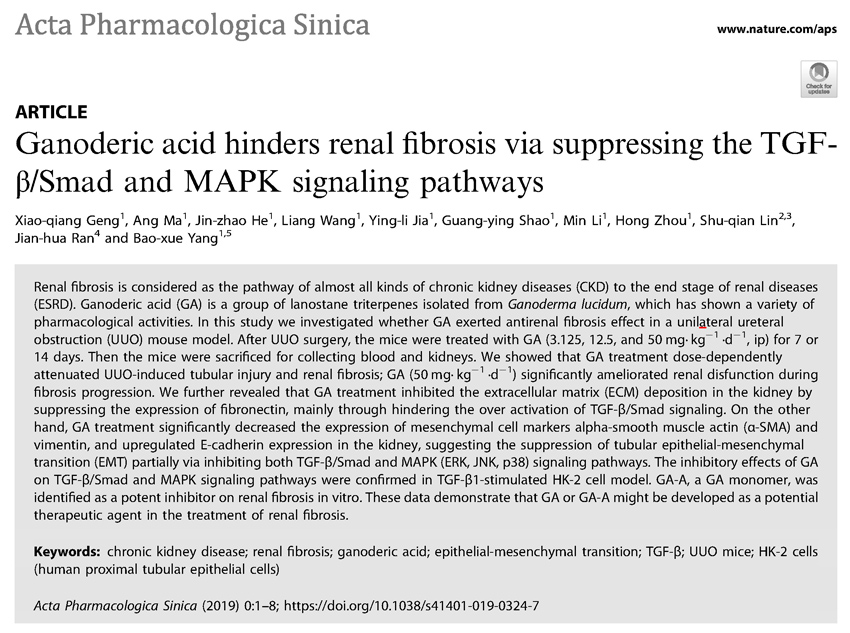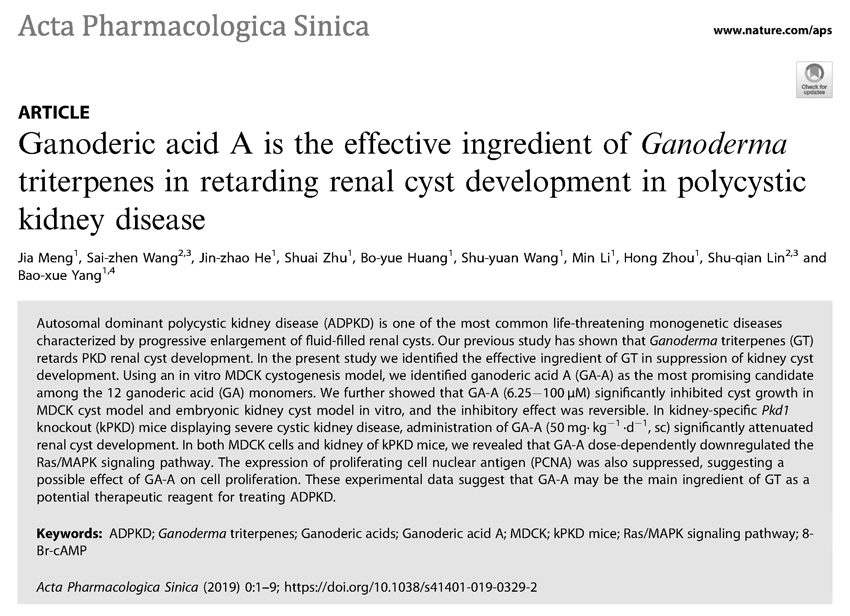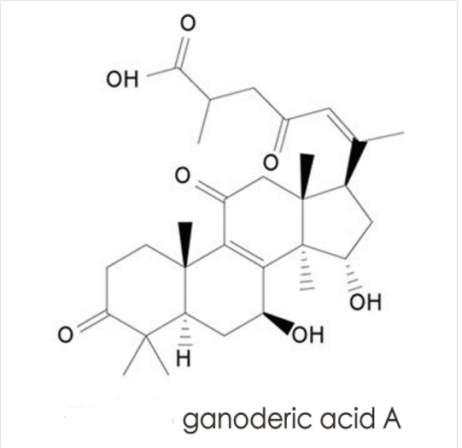Janvier 2020/Université de Pékin/Acta Pharmacologica Sinica
Texte/ Wu Tingyao
L'équipe dirigée par le professeur Baoxue Yang, président du département de pharmacologie, Université de Pékin, a publié deux articles dans Acta Pharmacologica Sinica au début 2020, confirmant queGanoderma lucidum les triterpènes peuvent retarder la progression de la fibrose rénale et de la polykystose rénale, et leurs principaux composants fonctionnels sont l'acide ganodérique A.
L'acide ganodérique retarde la progression de la fibrose rénale.

Les chercheurs ont attaché l'uretère d'un côté de la souris. Quatorze jours plus tard, la souris développerait une fibrose rénale due à une obstruction de la miction et au reflux de l'urine. At the same time, son azote uréique dans le sang (CHIGNON) et la créatinine (Cr) augmentera également, indiquant une insuffisance rénale.
Cependant, si l'acide ganodérique est administré à une dose quotidienne de 50 mg/kg par injection intrapéritonéale immédiatement après la ligature de l'uretère, le degré de fibrose rénale ou d'insuffisance rénale sera considérablement réduit après 14 days.
Une analyse plus approfondie du mécanisme d'action associé montre que l'acide ganodérique peut empêcher la progression de la fibrose rénale sous au moins deux aspects.:
D'abord, les acides ganodériques empêchent les cellules épithéliales des tubes rénaux normaux de se transformer en cellules mésenchymateuses qui sécrètent des substances liées à la fibrose (ce processus est appelé transition épithéliale-mésenchymateuse, EMT); deuxième, les acides ganodériques peuvent réduire l'expression de la fibronectine et d'autres substances liées à la fibrose.
En tant que triterpénoïde le plus abondant deGanoderma lucidum, L'acide ganodérique a de nombreuses sortes. Afin de confirmer quel acide ganodérique exerce l'effet de protection rénale mentionné ci-dessus, les chercheurs ont cultivé les principaux acides ganodériques A, B, et C2 avec des lignées cellulaires épithéliales des tubes rénaux humains à une concentration de 100 μg/mL. At the same time, le facteur de croissance TGF-β1, ce qui est indispensable à la progression de la fibrose, est ajouté pour inciter les cellules à sécréter des protéines liées à la fibrose.
Les résultats montrent que l'acide ganodérique A a le meilleur effet pour inhiber la sécrétion de protéines liées à la fibrose dans les cellules., et son effet est encore plus fort que celui du mélange d'acide ganodérique original. Donc, les chercheurs pensent queGanoderma lucidum est la source active de réduction de la fibrose rénale. Il est particulièrement intéressant que l'acide ganodérique A n'ait aucun effet toxique sur les cellules rénales et ne tue ni ne lése les cellules rénales..
Les acides ganodériques retardent la progression de la polykystose rénale.

Contrairement à la fibrose rénale, qui est principalement causée par des facteurs externes tels que les maladies et les médicaments, la maladie polykystique des reins est causée par une mutation génétique sur le chromosome. Les vésicules des deux côtés du rein deviendront progressivement plus grosses et plus nombreuses, ce qui exercera une pression sur les tissus rénaux normaux et altèrera la fonction rénale..
Précédemment, L’équipe de Baoxue Yang l’a prouvéGanoderma lucidum les triterpènes peuvent retarder la progression de la polykystose rénale et protéger la fonction rénale. Cependant, leGanoderma lucidum les triterpènes utilisés dans l'expérience comprennent au moins les acides ganodériques A, B, C2, D, F, G, T, DM et acides ganodéréniques A, B, D, et F.
Afin de connaître les principes actifs clés, les chercheurs ont examiné 12 types de triterpènes un par un grâce à des expériences in vitro et ont constaté qu'aucun d'entre eux n'affecte la survie des cellules rénales, mais qu'ils présentent des différences significatives dans l'inhibition de la croissance des vésicules.. Parmi eux, l'acide ganodérique A a le meilleur effet.
En outre, l'acide ganodérique A a été cultivé in vitro avec des reins de souris embryonnaires et les agents induisant la formation de vésicules. Par conséquent, l'acide ganodérique A peut toujours inhiber le nombre et la taille des vésicules sans affecter la croissance des reins. Sa dose efficace était de 100μg/mL, la même que la dose de triterpènes utilisée dans les expériences précédentes.
Des expériences sur des animaux ont également montré que l'injection sous-cutanée de 50 mg/kg d'acide ganodérique A chez des souris de petite taille atteintes de maladie polykystique des reins, chaque jour, après quatre jours de traitement, peut améliorer le gonflement des reins sans affecter le poids du foie et le poids corporel. Il réduit également le volume et le nombre de vésicules rénales, de sorte que l'aire de répartition des vésicules rénales est réduite d'environ 40% par rapport au groupe témoin sans protection par acide ganodérique A.
Puisque la dose efficace d'acide ganodérique A dans l'expérience était un quart de la même expérience avecGanodermielucidum triterpènes, il est démontré que l'acide ganodérique A est bien le composant clé deGanodermielucidum triterpènes pour retarder la progression de la maladie polykystique des reins. L'application de la même dose d'acide ganodérique A à des souris nouveau-nées normales n'a pas affecté la taille de leurs reins, indiquant que l'acide ganodérique A a un certain degré de sécurité.
De la fibrose rénale à l'insuffisance rénale, on peut dire que la maladie rénale chronique causée par diverses causes (comme le diabète) ira inévitablement sur un chemin sans retour.
Pour les patients atteints de maladie polykystique des reins, le taux de déclin de la fonction rénale peut être plus rapide. Selon les statistiques, environ la moitié des patients atteints de maladie polykystique des reins évolueront vers une insuffisance rénale vers l'âge de 60 et nécessitent une dialyse à vie.
Que le facteur pathogène soit acquis ou congénital, il n’est pas facile « d’inverser la fonction rénale »! Cependant, si le taux de détérioration des reins peut être ralenti afin de pouvoir être équilibré avec la durée de vie, il est peut-être possible de rendre la vie des malades moins pessimiste et plus pittoresque.
Grâce à des expériences cellulaires et animales, L'équipe de recherche de Baoxue Yang a prouvé que l'acide ganodérique A, qui représente la proportion la plus élevée deGanoderma lucidum triterpènes, est un élément indicateur deGanoderma lucidum pour protéger le rein.

Ce résultat de recherche souligne que la recherche scientifique deGanoderma lucidum est si solide qu'il peut vous indiquer quel ingrédient produit les effets deGanoderma lucidum viennent principalement du lieu de simplement dessiner une tarte fantastique pour votre imagination. Bien sûr, cela ne veut pas dire que seul l’acide ganodérique A peut protéger le rein. En fait, quelques autres ingrédients deGanoderma lucidum sont définitivement bénéfiques pour les reins.
Par exemple, un autre article publié par l’équipe de Baoxue Yang sur le thème de la protection du rein soulignait queGanoderma lucidum l'extrait de polysaccharide peut réduire les dommages oxydatifs du tissu rénal grâce à son effet antioxydant. Le "Ganoderma lucidum triterpènes totaux », qui contiennent divers triterpénoïdes tels que les acides ganodériques, acides ganodéréniques et ganodériols, travailler ensemble pour retarder la progression de la fibrose rénale et de la polykystose rénale, ce qui surprend aussi les scientifiques.
De plus, la nécessité de protéger le rein n’est pas résolue par la seule protection du rein. D'autres choses comme la régulation de l'immunité, améliorer les trois sommets, équilibrer le système endocrinien, calmer les nerfs et favoriser le sommeil sont certainement utiles pour protéger les reins. Ces problèmes ne peuvent pas être complètement résolus par l'acide ganodérique A seul..
La préciosité deGanoderma lucidum réside dans ses ingrédients diversifiés et ses fonctions polyvalentes, qui peuvent se coordonner pour produire le meilleur équilibre pour le corps. Autrement dit, si l'acide ganodérique A fait défaut, le travail de protection rénale manquera de beaucoup de force de combat, comme une équipe dépourvue des principaux acteurs.
Ganoderma lucidum à l'acide ganodérique A est plus à la hauteur de nos attentes en raison de son meilleur effet protecteur sur les reins.
[Source de données]
1. XQ, et autres. L'acide ganodérique entrave la fibrose rénale en supprimant les voies de signalisation TGF-β/Smad et MAPK. Acta Pharmacol Sin. 2020, 41: 670-677. est-ce que je: 10.1038/s41401-019-0324-7.
2. Meng J., et autres. L'acide ganodérique A est l'ingrédient efficace des triterpènes Ganoderma pour retarder le développement des kystes rénaux dans la maladie polykystique rénale.. Acta Pharmacol Sin. 2020, 41: 782-790. est-ce que je: 10.1038/s41401-019-0329-2.
3. Sur le, et autres. Les ganoderma triterpènes retardent le développement des kystes rénaux en régulant négativement la signalisation Ras/MAPK et en favorisant la différenciation cellulaire. Rein Int. 2017 Déc; 92(6): 1404-1418. est-ce que je: 10.1016/j.out.04.013.2017.
4. Zhong D., et autres. Le peptide polysaccharide Ganoderma lucidum prévient les lésions de reperfusion d'ischémie rénale en luttant contre le stress oxydatif. Représentant scientifique. 2015 Nov 25; 5: 16910. est-ce que je: 10.1038/srep16910.
FIN
À propos de l'auteur/Mme. Wu Tingyao
Wu Tingyao a fait un reportage de première main Ganoderma lucidum informations depuis 1999. Elle est l'auteur de Guérir avec Ganoderma (publié dans The People's Medical Publishing House en avril 2017).
★ Cet article est publié sous l'autorisation exclusive de l'auteur
★ Les œuvres ci-dessus ne peuvent pas être reproduites, extrait ou utilisé d’une autre manière sans l’autorisation de l’auteur
★ Violation de la déclaration ci-dessus, l'auteur poursuivra ses responsabilités légales y afférentes
★ Le texte original de cet article a été rédigé en chinois par Wu Tingyao et traduit en anglais par Alfred Liu.. S'il y a une divergence entre la traduction (Anglais) et l'original (Chinois), le chinois original prévaudra. Si les lecteurs ont des questions, veuillez contacter l'auteur original, MS. Wu Tingyao.



